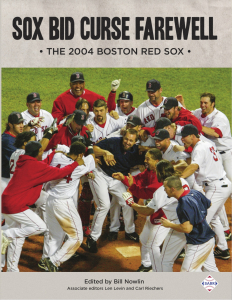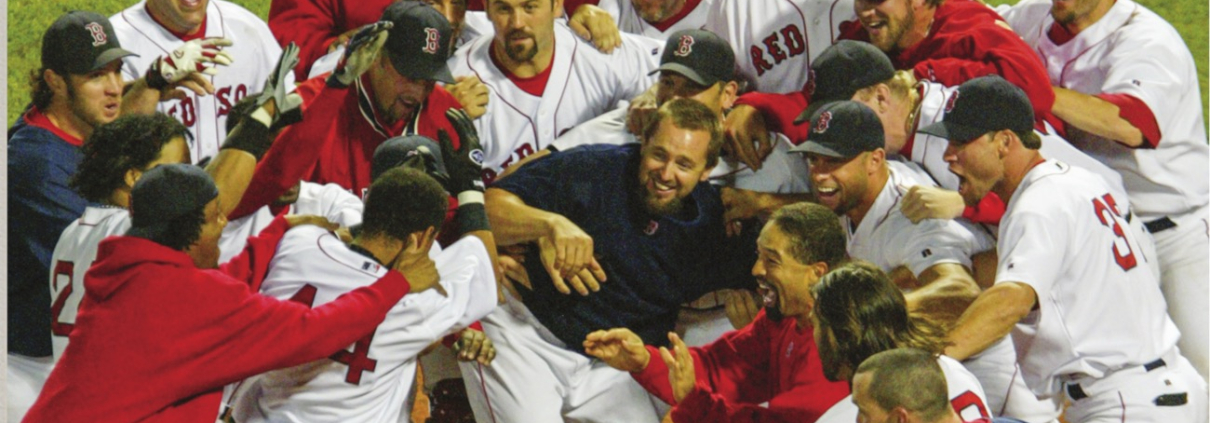Down on the Farm: The Story of the 2004 Sarasota Red Sox
This article was written by Christopher D. Chavis
This article was published in Sox Bid Curse Farewell: The 2004 Boston Red Sox
 Jon Lester, Jonathan Papelbon, Hanley Ramirez, and Dustin Pedroia – names you likely would not expect to read about in a book about the 2004 Boston Red Sox. After all, these men were key players in the 2007 World Series championship. Lester, Papelbon, and Pedroia were on the team, while Ramirez was traded to the Florida Marlins for Josh Beckett and 2007 World Series MVP Mike Lowell. However, it is difficult to fully tell the story of the 2004 Red Sox without understanding the moves that were being made to secure a future championship. Not because the Red Sox were destined to win a World Series in 2004 but because if “the curse” had reared its ugly head again, this was the core that would continue the fight to bring a World Series championship back to Boston.
Jon Lester, Jonathan Papelbon, Hanley Ramirez, and Dustin Pedroia – names you likely would not expect to read about in a book about the 2004 Boston Red Sox. After all, these men were key players in the 2007 World Series championship. Lester, Papelbon, and Pedroia were on the team, while Ramirez was traded to the Florida Marlins for Josh Beckett and 2007 World Series MVP Mike Lowell. However, it is difficult to fully tell the story of the 2004 Red Sox without understanding the moves that were being made to secure a future championship. Not because the Red Sox were destined to win a World Series in 2004 but because if “the curse” had reared its ugly head again, this was the core that would continue the fight to bring a World Series championship back to Boston.
All four men would appear at varying points in the season down in Sarasota, Florida, for the Sarasota Red Sox, the Red Sox Advanced-A affiliate in the Florida State League.
Jon Lester
Jon Lester almost started 2004 in the Texas Rangers farm system. If all had gone according to plan, he would have been a part of a trade that brought Alex Rodriguez to Boston. In 2003 he had gone 6-9 and posted a 3.65 ERA with the Augusta (South Carolina) Greenjackets, the Red Sox Low-A affiliate, and entered minor-league camp projected to end up in Sarasota.1
Lester battled injuries in the late spring and early summer, which temporarily sidelined him.2 However, the injuries did not stop his momentum as he continued progressing up the ladder in the Red Sox organization. By the late summer, the team was thinking about moving him up to the Double-A Portland (Maine) Sea Dogs in 2005. He became a consistent strikeout threat with a fastball reaching 96 MPH.3
Lester ended 2004 ranked by Baseball America as the fourth-best prospect in the Red Sox system.4
Projected to join him in the 2005 Portland rotation was future closer Jonathan Papelbon …
Jonathan Papelbon
Jonathan Papelbon, a 2003 draft pick, entered 2004 as a starter for the Sarasota Red Sox. The idea of Papelbon as a starter is likely foreign to most Red Sox fans, but before transitioning to closer, he worked his way through the Red Sox minor-league system as a starter. And frankly, he was not terrible. During their time together in Sarasota, Papelbon kept pace with and sometimes outperformed Lester. By May 9, Papelbon was 3-1 with a 2.86 ERA in 28⅓ innings pitched, outpacing Lester, who was 1-2 with a 5.48 ERA in 21⅓ innings pitched.5 While Lester improved throughout May and ultimately ended the month with a 4-3 record with a 4.14 ERA in 45⅔ innings pitched, Papelbon kept up his pace and ended the month with a 4-3 record with a 3.16 ERA in 51⅓ innings pitched.6 A direct comparison between the two became more difficult after May as Lester struggled with injuries and spent time on the disabled list.7
Papelbon’s success even sparked calls to have him promoted to Portland in mid-2004, prompting Red Sox general manager Theo Epstein to shoot down these calls by saying that Papelbon needed to stay in Sarasota to work on his offspeed stuff.8 Luckily for Papelbon, the Red Sox eventually embraced his firepower and moved him into the closer role in 2007.
Papelbon ended 2004 ranked by Baseball America as the third-best prospect in the Red Sox organization, just ahead of Jon Lester.9
Papelbon was ultimately selected to the Florida State League All-Star Game, an honor he shared with Hanley Ramirez …
Hanley Ramirez
Hanley Ramirez entered 2004 as the top prospect in the Red Sox system and the top prospect in all of baseball.10 He even started the year playing with the Red Sox in spring training, and there were talks of his starting the year in Portland, not Sarasota.11 Despite these predictions, Ramirez joined the squad in Sarasota.12
Ramirez started strong, batting over .300 through April and May. However, despite his best efforts to play through it, a wrist injury sidelined him for a month at the end of May.13 Despite being named to the All-Star team, Ramirez could not play.14
When he returned from injury, he picked up from where he left off, hitting .362 in his first 14 games in July.15 His performance with Sarasota earned him recognition as the best defensive shortstop in the Florida State League and a promotion to Double-A Portland.16 At the end of the season, Ramirez retained his spot as the top prospect in the Red Sox system.17
Ramirez’s promotion opened the door for new draft pick Dustin Pedroia …
Dustin Pedroia
Dustin Pedroia started in 2004, not in Boston, but at Arizona State University. In June he was selected by the Red Sox in the second round (65th overall) of the amateur draft.18 He was the Red Sox’ first pick in the draft. The team had lost its prior pick as compensation to the Oakland A’s for signing Keith Foulke. Pedroia had excelled at Arizona State, having been named the best collegiate defensive player in the nation in 2003 and batting .384 with a .466 on-base percentage during his three years there.19 Baseball America ranked him as the second-best defensive player in the draft.20 Given his résumé, the Red Sox had actually expected him to go higher in the draft.21 Luckily for the Red Sox, Pedroia ultimately ended up in Boston.
After he signed with the Red Sox in July, the team assigned him to the Single-A Augusta GreenJackets.22 The Red Sox planned for him to spend a couple of weeks in Augusta and then move to Sarasota.23 After 12 games in Augusta, Pedroia moved to Sarasota, where he batted.307 batting with a .382 on-base percentage in his first 24 games without committing an error.24 It was a strong start, and it only got stronger. Pedroia ultimately played 30 games in Sarasota, posting a .336 batting average.25
Pedroia visited Fenway Park on September 20, and took batting practice with the team. It was his first time in Boston.26 He ended the season ranked by Baseball America as the sixth-best prospect in the Red Sox organization.27
The 2004 Sarasota Red Sox
How did the team itself actually do? Despite its wealth of future stars, the Sarasota Red Sox finished 37-30, third in the Western Division of the Florida State League and out of the playoffs.28 At the end of the season, the team opted to leave the Florida State League in favor of the Carolina League. Starting in 2005, the Wilmington Blue Rocks replaced the Sarasota Red Sox as the Advanced Class-A affiliate of the Boston Red Sox.29
The legacy of the 2004 Sarasota Red Sox extends beyond its on-field performance. It incubated future stars and pieces for a Red Sox World Series team. It was also unusual for the number of future stars it had. There were more future pieces in Sarasota than in either Portland or Pawtucket. By the end of the season, six of the Red Sox’ top 10 prospects had spent time there.30 Aside from Pedroia, Papelbon, and Lester, Manny DelCarmen and Brandon Moss also spent time with Sarasota and, ultimately, with the 2007 Boston Red Sox. However, DelCarmen was the only one of the two actually to appear with the team in the playoffs. While Hanley Ramirez was not a part of the 2007 team, he was a crucial part of the trade that brought vital pieces of that team to Boston.
In 2004, the future of the Boston Red Sox was in Sarasota.
CHRISTOPHER D. CHAVIS’s love affair with the Boston Red Sox began as an undergraduate at Dartmouth College in New Hampshire, where his frequent trips to Fenway Park instilled in him a love of the Olde Towne Team that spawned a deep interest in baseball history. A public-policy researcher and nonprofit leader by day and amateur baseball historian by night, he can usually be found reading a book or watching a documentary about the Sox. He lives in Los Angeles with his wife and two cats, Teddy and Yaz.
Notes
1 Gordon Edes, “He’s Dealing With It Just Fine,” Boston Globe, February 27, 2004: E6.
2 Bob Hohler, “Youthful Farm Hands Making Hay,” Boston Globe, June 20, 2004: E10.
3 Gordon Edes, “Baseball Notes,” Boston Globe, August 8, 2004: C12.
4 Gordon Edes, “Checking on Short Subjects,” Boston Globe, November 14, 2004: D10.
5 “Minor League Red Sox Statistics,” Boston Globe, May 9, 2004: C10.
6 “Red Sox Minor League Averages,” Boston Globe, May 30, 2004: C9.
7 Bob Hohler, “Youthful Farm Hands Making Hay,” Boston Globe, June 20, 2004: E10.
8 “Youthful Farm Hands Making Hay.”
9 Gordon Edes, “Checking on Short Subjects.”
10 “Gordon Edes, “Selig Denies Playing Favorites,” Boston Globe, January 11, 2004: D2.
11 Nick Cafardo, “In-Depth Look at Injuries,” Boston Globe, March 20, 2004: D2.
12 Chris Umpierre, “Sarasota Collects 6-4 Win Against Sloppy Fort Myers,” Fort Myers (Florida) News-Press, April 10, 2004: C7.
13 Nick Cafardo, “Garciaparra to Play for PawSox Tonight,” Boston Globe, May 30, 2004: C8.
14 Bob Hohler, “West Going in the Right Direction,” Boston Globe, June 6, 2004: C9.
15 Nick Cafardo, “He’s Short on Patience,” Boston Globe, July 18, 2004: D10.
16 Gordon Edes, “Baseball Notes,” Boston Globe, August 8, 2004: C12.
17 Gordon Edes, “Checking on Short Subjects,” Boston Globe, November 14, 2004: D10.
18 “Red Sox Draft Picks,” Boston Globe, June 8, 2004: F5.
19 Bob Hohler, “It’s Reunion Time For Padres Alumni,” Boston Globe, June 8, 2004: F5.
20 Gordon Edes, “Age Hasn’t Caught Up Yet,” Boston Globe, June 13, 2004: C12.
21 Bob Hohler, “It’s Reunion Time For Padres Alumni,” Boston Globe, June 8, 2004: F5.
22 “Boston Signs Top Draft Pick,” North Adams (Massachusetts) Transcript, July 14, 2004: B3.
23 Nick Cafardo, “He’s Short on Patience,” Boston Globe, July 18, 2004: D10
24 Bob Hohler, “Only a few will realize big dreams,” Boston Globe, August 29, 2004: F11
25 Peter May, “Wife’s surgery sends Cabrera on Home Run,” Boston Globe, September 21, 2004: F5
26 Peter May, “Wife’s surgery sends Cabrera on Home Run,” Boston Globe, September 21, 2004: F5
27 Gordon Edes, “Checking on Short Subjects,” Boston Globe, November 14, 2004: D10.
28 “Minor League Beat,” Orlando Sentinel, September 6, 2004: D12.
29 “Sox Leave Sarasota,” (Fort Myers) News-Press, September 23, 2004: C2.
30 Gordon Edes, “Checking on Short Subjects,” Boston Globe, November 14, 2004: D10.


